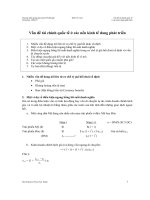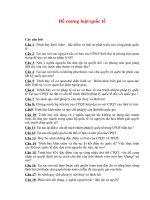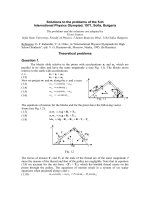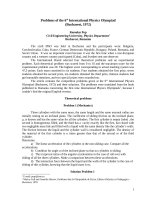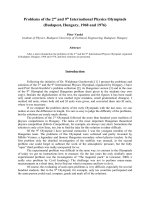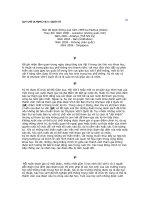Đề IPHO(vật lí quốc tế) 1970
Bạn đang xem bản rút gọn của tài liệu. Xem và tải ngay bản đầy đủ của tài liệu tại đây (149.59 KB, 9 trang )
Problems of the IV International Olympiad, Moscow, 1970
The publication is prepared by Prof. S. Kozel & Prof. V.Orlov
(Moscow Institute of Physics and Technology)
The IV International Olympiad in Physics for schoolchildren took place in Moscow (USSR) in July
1970 on the basis of Moscow State University. Teams from 8 countries participated in the
competition, namely Bulgaria, Hungary, Poland, Romania, Czechoslovakia, the DDR, the SFR
Yugoslavia, the USSR. The problems for the theoretical competition have been prepared by the
group from Moscow University stuff headed by professor V.Zubov. The problem for the experimental
competition has been worked out by B. Zvorikin from the Academy of Pedagogical Sciences.
It is pity that marking schemes were not preserved.
Theoretical Problems
Problem 1.
A long bar with the mass M = 1 kg is placed on a smooth horizontal surface of a table where it can
move frictionless. A carriage equipped with a motor can slide along the upper horizontal panel of
the bar, the mass of the carriage is m = 0.1 kg. The friction coefficient of the carriage is μ = 0.02.
The motor is winding a thread around a shaft at a constant speed v
0
= 0.1 m/s. The other end of the
thread is tied up to a rather distant stationary support in one case (Fig.1, a), whereas in the other case
it is attached to a picket at the edge of the bar (Fig.1, b). While holding the bar fixed one allows the
carriage to start moving at the velocity V
0
then the bar is let loose.
Fig. 1 Fig. 2
By the moment the bar is released the front edge of the carriage is at the distance l = 0.5 m
from the front edge of the bar. For both cases find the laws of movement of both the bar and the
carriage and the time during which the carriage will reach the front edge of the bar.
Problem 2.
1
A unit cell of a crystal of natrium chloride (common salt- NaCl) is a cube with the edge length a =
5.6ּ10
-10
m (Fig.2). The black circles in the figure stand for the position of natrium atoms whereas the
white ones are chlorine atoms. The entire crystal of common salt turns out to be a repetition of such
unit cells. The relative atomic mass of natrium is 23 and that of chlorine is 35,5. The density of the
common salt ρ = 2.22ּ10
3
kg/m
3
. Find the mass of a hydrogen atom.
Problem 3.
Inside a thin-walled metal sphere with radius R=20 cm there is a metal ball with the radius r = 10 cm
which has a common centre with the sphere. The ball is connected with a very long wire to the Earth
via an opening in the sphere (Fig. 3). A charge Q = 10
-8
C is placed onto the outside sphere. Calculate
the potential of this sphere, electrical capacity of the obtained system of conducting bodies and draw
out an equivalent electric scheme.
Fig. 3 Fig. 4
Problem 4.
A spherical mirror is installed into a telescope. Its lateral diameter is D=0,5 m and the radius of the
curvature R=2 m. In the main focus of the mirror there is an emission receiver in the form of a round
disk. The disk is placed perpendicular to the optical axis of the mirror (Fig.7). What should the radius
r of the receiver be so that it could receive the entire flux of the emission reflected by the mirror?
How would the received flux of the emission decrease if the detector’s dimensions decreased by 8
times?
Directions: 1) When calculating small values α (α<<1) one may perform a substitution
2
11
α
α
−≈−
; 2) diffraction should not be taken into account.
2
Experimental Problem
Determine the focal distances of lenses.
List of instruments : three different lenses installed on posts, a screen bearing an image of a
geometric figure, some vertical wiring also fixed on the posts and a ruler.
Solutions of the problems of the IV International Olympiad, Moscow, 1970
Theoretical Competition
Problem 1.
a) By the moment of releasing the bar the carriage has a velocity v
0
relative to the table and continues
to move at the same velocity.
The bar, influenced by the friction force F
fr
= μmg from the carriage, gets an acceleration
a = F
fr
/ M = μmg/M ; a = 0.02 m/s , while the velocity of the bar changes with time according to the
law v
b
= at. .
Since the bar can not move faster than the carriage then at a moment of time t = t
0
its
sliding will stop, that is v
b
= v
0
. Let us determine this moment of time:
s5
00
0
===
mg
Mv
a
v
t
µ
By that moment the displacement of the Sb bar and the carriage Sc relative to the table will be equal
to
mg
Mv
tvS
µ
2
0
00c
==
,
mg
Mvat
S
b
µ
22
2
0
2
0
==
.
The displacement of the carriage relative to the bar is equal to
m25.0
2
2
0
c
==−=
mg
Mv
SSS
b
µ
Since S<l, the carriage will not reach the edge of the bar until the bar is stopped by an
immovable support. The distance to the support is not indicated in the problem condition so we can
not calculate this time. Thus, the carriage is moving evenly at the velocity v
0
= 0.1 m/s, whereas the
bar is moving for the first 5 sec uniformly accelerated with an acceleration a = 0.02 m/s and then
the bar is moving with constant velocity together with the carriage.
b) Since there is no friction between the bar and the table surface the system of the bodies
“bar-carriage” is a closed one. For this system one can apply the law of conservation of momentum:
mv + Mu = mv
0
(1)
3
where v and u are projections of velocities of the carriage and the bar relative to the table onto the
horizontal axis directed along the vector of the velocity v
0
. The velocity of the thread winding v
0
is
equal to the velocity of the carriage relative to the bar (v-u), that is
v
0
= v – u (2)
Solving the system of equations (1) and (2) we obtain:
u = 0 , v = v
0 .
Thus, being released the bar remains fixed relative to the table, whereas the carriage will be moving
with the same velocity v
0
and will reach the edge of the bar within the time t equal to
t = l/v
0
= 5 s.
Problem 2.
Let’s calculate the quantities of natrium atoms (n
1
) and chlorine atoms (n
2
) embedded in a single NaCl
unit crystal cell (Fig.2).
One atom of natrium occupies the middle of the cell and it entirely belongs to the cell. 12
atoms of natrium hold the edges of a large cube and they belong to three more cells so as 1/4 part of
each belongs to the first cell. Thus we have
n
1
= 1+12⋅1/4 = 4 atoms of natrium per unit cell.
In one cell there are 6 atoms of chlorine placed on the side of the cube and 8 placed in the
vertices. Each atom from a side belongs to another cell and the atom in the vertex - to seven others.
Then for one cell we have
n
2
= 6⋅1/2 + 8⋅ 1/8 = 4 atoms of chlorine.
Thus 4 atoms of natriun and 4 atoms of chlorine belong to one unit cell of NaCl crystal.
The mass m of such a cell is equal
m = 4(m
rNa
+ m
rCl
) (amu),
where m
rNa
and m
rCl
are relative atomic masses of natrium and clorine. Since the mass of hydrogen
atom m
H
is approximately equal to one atomic mass unit: m
H
= 1.008 amu ≈ 1 amu then the mass of
an unit cell of NaCl is
m = 4(m
rNa
+ m
rCl
) m
H
.
On the other hand, it is equal m = ρa
3
, hence
( )
kg1067.1
4
27
rClrNa
3
H
−
⋅≈
+
=
mm
a
m
ρ
.
Problem 3.
Having no charge on the ball the sphere has the potential
V450
4
1
0
0s
==
R
Q
πε
ϕ
.
4
When connected with the Earth the ball inside the sphere has the potential equal to zero so there is
an electric field between the ball and the sphere. This field moves a certain charge q from the Earth to
the ball. Charge Q`, uniformly distributed on the sphere, doesn’t create any field inside thus the
electric field inside the sphere is defined by the ball’s charge q. The potential difference between the
balls and the sphere is equal
,
4
1
0
sb
−=−=∆
R
q
r
q
πε
ϕϕϕ
(1)
Outside the sphere the field is the same as in the case when all the charges were placed in its
center. When the ball was connected with the Earth the potential of the sphere φ
s
is equal
.
4
1
0
s
R
+
=
πε
ϕ
(2)
Then the potential of the ball
0
4
1
4
1
00
sb
=
+=
−+
+
=∆+=
r
q
R
Q
R
q
r
q
R
πεπε
ϕϕϕ
(3)
Which leads to
R
r
−=
. (4)
Substituting (4) into (2) we obtain for potential of the sphere to be found:
( )
.V225
4
1
4
1
2
00
s
=
−
=
−
=
R
rRQ
R
R
r
πεπε
ϕ
The electric capacity of whole system of conductors is
44pFF104.4
4
11
2
0
s
=⋅=
−
==
−
rR
R
Q
C
πε
ϕ
The equivalent electric scheme consists of two parallel capacitors: 1) a spherical one with charges
+q and –q at the plates and 2) a capacitor “sphere – Earth” with charges +(Q-q) and
–(Q–q) at the plates (Fig.5).
Fig. 5 Fig. 6
Problem 4.
5
